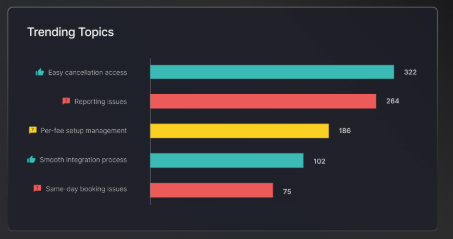We look forward to showing you Velaris, but first we'd like to know a little bit about you.
Totango vs Vitally
For Customer Success and post-sales professionals, managing accounts without a dedicated Customer Success Platform often means dealing with challenges like:
- Scattered data across multiple tools
- Relying on spreadsheets and manual tracking
- Missed renewal and expansion opportunities
- Limited visibility into customer health
- Difficulty showing impact to leadership
To solve these problems, many teams turn to platforms like Totango and Vitally. And now, more modern options like Velaris bring AI, automation, and simpler setup into the picture.
Let’s compare Totango and Vitally, while also showing how Velaris stacks up as an alternative.
Comparing Totango vs Vitally vs Velaris
*Exact pricing varies by vendor and contract structure.
Platform overviews
Totango
Totango is built around a modular structure, offering different products that teams can combine based on their needs. It’s known for its customer journey mapping and prebuilt templates that help standardize workflows. While flexible, Totango can feel fragmented at times and may require significant setup to get the most out of it. It’s often a fit for mid-market or enterprise teams that have the resources to configure and maintain the system.
Vitally
Vitally is known for being a user-friendly CS platform. It provides strong collaboration tools, clear analytics, and several plug-and-play integrations. It’s particularly attractive for growing SaaS companies that want to get started quickly without a steep learning curve. However, as companies scale, some may find Vitally less comprehensive than enterprise-focused alternatives, especially in terms of integration depth.
Velaris
Velaris represents a newer approach to Customer Success. It’s an AI-first platform designed to give teams deep visibility into accounts while automating repetitive tasks. With 70+ integrations, simple setup, and built-in predictive insights, Velaris focuses on efficiency and usability. It’s particularly well-suited for mid-market and enterprise teams that want the power of automation and analytics without the heavy admin burden that comes with legacy platforms.

Feature comparison
Data consolidation and visibility
- Totango: Offers modular tools for journey mapping and segmentation, but data can feel spread out across modules. Integrations are available but may require effort to configure.
- Vitally: Provides clear account views and shared workspaces to keep customer data accessible. Strong for collaboration, but may not go as deep in consolidation as larger platforms.
- Velaris: Centralizes data from all your systems into a single view. Designed for real-time visibility with AI features such as account summaries, Slack summaries and meeting analysis, making it easier for teams to see the full customer picture. Supports 70+ integrations and deep customization.

Customer health and analytics
- Totango: Provides customer health scoring and reporting, but customization can take time. Analytics are solid once configured.
- Vitally: Delivers straightforward health scoring and analytics.
- Velaris: Includes AI-driven health scores and predictive analytics out of the box. Designed to reduce manual setup while helping teams identify risks and opportunities early. One advantage of Velaris is that it can analyze both quantitative and qualitative data. By analyzing customer comms in tickets, emails and messages, Velaris can report on recurring themes and patterns in them.

Digital Customer Success and automation
- Totango: Offers playbooks and journey-based automation. Good for structuring repeatable workflows, though it may require manual fine-tuning.
- Vitally: Includes automation features like tasks and triggers to streamline repetitive processes. Best for teams seeking simple automation tied to collaboration.
- Velaris: Uses a visual automation builder and AI tools to automate routine tasks, and personalize outreach at scale. Built to reduce manual admin work while scaling CS impact.
Project and task management
- Totango: Basic task management tied to its modular tools, with limited flexibility for broader project needs.
- Vitally: Provides easy-to-use task tracking and shared workspaces for collaborating directly with customers.
- Velaris: Built-in project and task management dashboards, ideal for managing onboarding, renewals, and joint success plans.
Other considerations
Ease of use
- Totango: Offers prebuilt templates to simplify setup, but its modular design can feel fragmented. Some learning curve is expected.
- Vitally: Designed to be straightforward and user-friendly. Teams can get up and running quickly, with a focus on collaboration.
- Velaris: Prioritizes simplicity with intuitive dashboards and automation. Designed to reduce admin overhead and get teams up and running quickly.
Scalability
- Totango: Scales with additional modules, though this can create complexity as you grow.
- Vitally: Well-suited for growing SaaS teams. However, larger enterprises may find it lacks some of the advanced complexity needed for scale.
- Velaris: Scales with mid-market and enterprise teams by combining AI, automation, and integrations, without requiring a dedicated ops team.
Integrations
- Totango: Provides integrations with major CRMs and tools, but setup can be manual and require ongoing maintenance.
- Vitally: Provides integrations for popular SaaS tools, making it easy for teams to connect their stack. Depth of integrations may be more limited than enterprise-grade platforms.
- Velaris: Offers 70+ integrations with real-time sync, aiming to make setup easier and reduce silos.
Support
- Totango: Provides documentation and customer support, though users sometimes note delays for complex issues.
- Vitally: Known for responsive support and straightforward onboarding, aligned with its focus on ease of use.
- Velaris: Emphasizes a hands-on approach with personalized onboarding and responsive support. Dedicated CSM and Slack channel offered to all customers.
AI Innovation
- Both Totango and Vitally have rolled out AI products by means of acquisition. However, these products are not part of their core Customer Success offering and need to be purchased separately.
- Velaris is an AI-first platform that has built AI into the foundations of their core offering. For Customer Success teams, this translates into AI that feels seamless, actionable, and accessible without needing to buy extra products or manage disconnected tools.
To see how Velaris’ AI can help your workflows, book a demo here.
Choosing the right platform
Who should pick Totango
Totango is best for teams that want flexibility and are comfortable managing a modular system. If you have the resources to configure workflows and maintain multiple product suites, Totango can provide strong journey management and automation options.
Who should pick Vitally
Vitally works well for growing SaaS teams that value ease of use and close collaboration with customers. If you want a platform that gets you up and running quickly, with clear analytics and simple automation, Vitally can meet those needs. It’s best suited for teams that don’t require the heavy customization of enterprise-focused platforms.
Who should consider Velaris
Velaris is designed for mid-market and enterprise teams that want advanced capabilities without heavy admin overhead. If your priorities are AI-driven insights, automation, and real-time visibility, Velaris offers a strong balance between power and usability. You can dive deeper into Velaris’ functionality by booking a personalized demo here.
Conclusion
Totango, Vitally, and Velaris each bring different strengths to the table. Totango offers modular flexibility, Vitally prioritizes ease of use and collaboration, and Velaris provides an AI-driven alternative designed for visibility and efficiency.
The right choice depends on your team’s goals, data structure, and the resources you have to manage a platform. What works for one organization may not be the best fit for another.
If you’re looking for an AI-driven platform that balances power with ease of use, book a demo with Velaris.


You’ll be working with cutting-edge AI technology that feels built-in, not bolted-on.
Connect 70+ tools and let Velaris engineers handle any customizations if you need them.
Forget a generic, automated support experience. You’ll have a Slack channel, CSM and implementation manager dedicated to you so you can get tailored support for your organization.
“Velaris is allowing our customer success team to handle many more accounts and stay on top of our complex projects.”


“Flexible platform and perfect for day-to-day operations in CS.”


A must-needed tool for your success team!”


"The best option to organize your customers and know their health."


Frequently Asked Questions
Velaris can be set up in just a few weeks. While the exact timeline depends on your needs, our team will guide you through every step including scoping, mapping, and migrating your data. You won’t need to do any work on your side, we’ll handle everything for you.
Velaris offers 70+ integrations, including easy plug-and-play connections and customizable flows that can be set up with a simple drag-and-drop builder. This flexibility lets you adapt your integrations as your needs change.
We’ve trained Velaris’ AI to think like a Customer Success expert, with a focus on the challenges you face every day in post-sales. We use best-in-class models and refine them constantly using customer feedback.
At Velaris, your data is always treated with the highest level of confidentiality. Our AI features run on private servers, and we never allow our model providers to train on your data.



.svg)